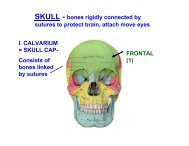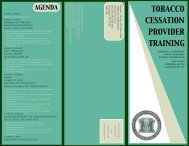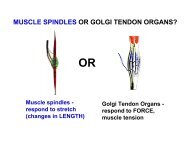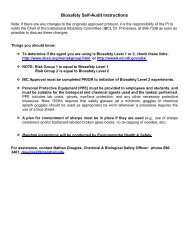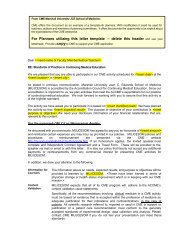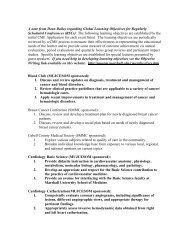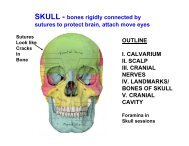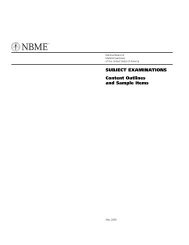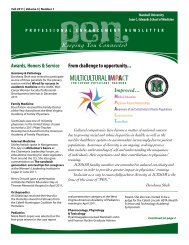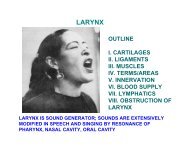FA 5 Progress Report WV-INBRE - Joan C. Edwards School of ...
FA 5 Progress Report WV-INBRE - Joan C. Edwards School of ...
FA 5 Progress Report WV-INBRE - Joan C. Edwards School of ...
- No tags were found...
Create successful ePaper yourself
Turn your PDF publications into a flip-book with our unique Google optimized e-Paper software.
Program Director/Principal Investigator (Last, First, Middle): Rankin, Gary O 56regulator within alternative macrophages (M2). Arginase mediated signaling decreases Tlymphocyte proliferation resulting in immune suppression. Markers <strong>of</strong> immune dysfunction in theearly post-stroke phase, such as the NLSF, TLR signals, arginase, and T-cell activity may proveuseful for identifying patients with increased risk <strong>of</strong> secondary complications. The mechanisms <strong>of</strong>post-stroke immune suppression will need further study and taken into account when developingstroke treatments impacting inflammatory and immune pathways.Submitted Manuscript:T. L. Barr, R. VanGilder, S. Rellick, Y. Conley, J. Ding, D. Chen, J. Denvir, A. Dillman, StevenWarach, Andrew Singleton, M. Matarin. Identification <strong>of</strong> a genomic pr<strong>of</strong>ile following ischemic strokethat may mediate stroke recovery. Submitted to Science Translational Medicine.6. Project #5:Regulation <strong>of</strong> brain endothelial phenotype and function by diabetic plasmaWe have previously identified that in the streptozotocin (STZ) model <strong>of</strong> diabetes there is a change inthe barrier properties <strong>of</strong> the brain endothelial cells that regulate both the physical and transportproperties <strong>of</strong> the blood brain barrier (BBB). These changes in BBB properties are prolonged andeventually become resistant to insulin therapy. Similar functional changes at the BBB have beenreported clinically. During diabetes there are a number <strong>of</strong> changes that occur in the blood. Severalfactors that change clinically are known regulators <strong>of</strong> BBB function, though their role in regulation <strong>of</strong>the diabetic BBB is unknown. Our current working hypothesis is that diabetes induces changes insignaling molecules within the blood that can in turn regulate both the phenotype and function <strong>of</strong> thebrain cerebromicrovasculature. Thus, the aim <strong>of</strong> this study is to investigate what role constituents<strong>of</strong> blood play in the regulation <strong>of</strong> BBB function in an animal model <strong>of</strong> diabetes.Specific Aim 1: Investigate changes in gene expression in brain microvasculature endothelial cellsin an animal model <strong>of</strong> diabetes.In our earlier ACORN report, we reported on our studies investigating the effects <strong>of</strong> STZ on barrierfunction <strong>of</strong> cerebral microvasculature. Our focus in this study was investigating the changes in theexpression <strong>of</strong> mRNA and proteins involved in VEGF and its signaling, at the blood brain barrier. Wefound increases in the mRNA <strong>of</strong> most <strong>of</strong> the genes in the VEGF signaling pathway. However wedid not see a comparable increase in the levels <strong>of</strong> protein. Subsequent studies indicated that thismay be due to regulation <strong>of</strong> translation via circulating microRNA. In this report we have two followup studies:1. Are the changes in VEGF similar in other barrier vascular beds <strong>of</strong> the Brain?Our studies to date have concentrated on the BBB in the cortex <strong>of</strong> rats. During our studies weroutinely collect the Choroid plexus, another brain barrier system that is heavily regulated by VEGF.Our hypothesis is that if circulating miRNA is indeed involved in regulating barrier VEGF then weshould see similar changes at the choroid plexus.Table 1: Comparison <strong>of</strong> protein changes by Western blot at the BBB and at the choroid plexusfrom STZ treated rats. [NC, no change]Cortex BBB Choroid PlexusVEGF NC NCFlt-1 NC NCFlk-1 ↑40% ↑45%From table 1, it is apparent that for the three proteins we have looked at so far (VEGF and its twomain receptors), that the changes are similar at the choroid plexus to those seen at the BBB,indicating that there may be similar regulation <strong>of</strong> both barrier systems.2. Is there a change in VEGF receptor activation?Changes in expression though important do not necessarily represent functional changes. ThusPHS 2590 (Rev. 06/09)Continuation Format Page



